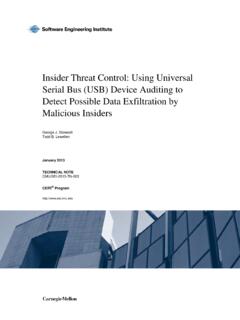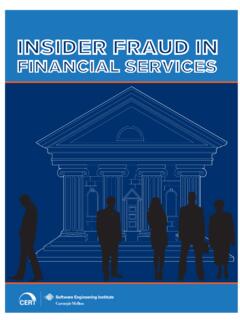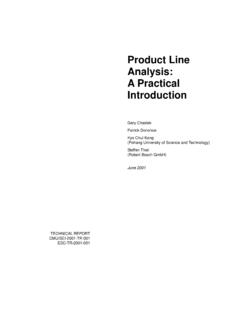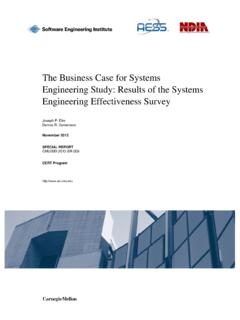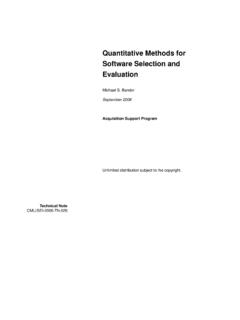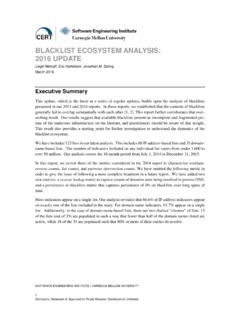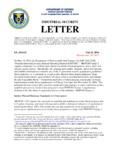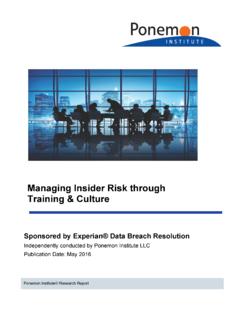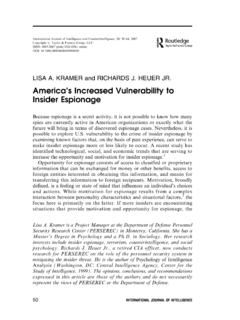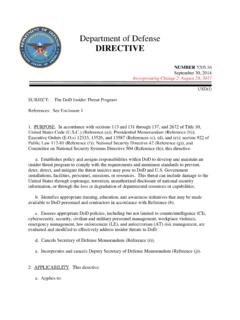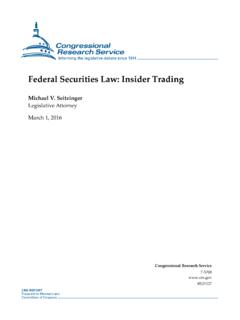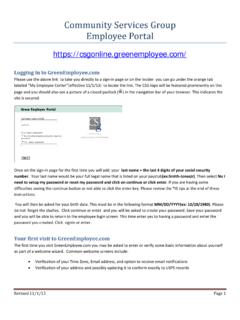Transcription of Analytic Approaches to Detect Insider Threats
1 Analytic Approaches TO Detect Insider Threats DECEMBER 9, 2015 TABLE OF CONTENTS EXECUTIVE SUMMARY .. 1 A. 3 1. BACKGROUND .. 3 2. OUTLINE .. 4 B. Insider THREAT PROGRAM OVERVIEW .. 5 1. INTRODUCTION .. 5 2. POLICY, PRIVACY, AND ETHICAL CONSIDERATIONS .. 5 3. LEGAL CONSIDERATIONS .. 6 4. COST CONSIDERATIONS .. 7 C. Insider THREAT AGENT AND ATTACK TYPES .. 7 D. Analytic INDICATORS .. 10 1. CONTEXT .. 10 2. Analytic 12 3. ACTIVITY-BASED ANALYTICS .. 13 a. System Indicators .. 14 b. Facility Indicators .. 18 c. Business Capabilities Indicators .. 18 4. CONTENT-BASED ANALYTICS .. 20 a. Social Analytics .. 20 b. Health Analytics .. 22 c. Human Resources Analytics .. 23 5. INFERENTIAL ANALYTICS .. 24 a. Financial 24 b. Security Analytics .. 25 c. Criminal Analytics .. 26 6. IMPORTANT ANALYTICS FOR ATTACK TYPES .. 27 E. Analytic PROCESS & INVESTIGATIONS .. 29 F. DATA SOURCES FOR ANALYTICS .. 29 1. DATA FROM SECURITY AND NETWORK COMPONENTS.
2 29 2. DATA PROCESSING FLOW AND KEY DATA ELEMENTS .. 34 3. HOW THE DATA RELATES TO ANALYTICS .. 36 4. DATA PROCESSING REQUIREMENTS AND CHALLENGES .. 38 G. 39 APPENDIX B: ASSUMPTIONS .. 46 BIBLIOGRAPHY .. 47 GLOSSARY .. 48 1 EXECUTIVE SUMMARY All organizations face security risks. With the growth of information technology-enabled infrastructure, these risks are manifested in the cyber domain. To Detect and mitigate therisks, organizations rely on continuous security assessment and monitoring programs. These programs must be conducted in compliance with applicable laws and the organization s ethical, and privacy policies. Of these security risks, some estimates show that over 50% are posed by insiders individuals with access to organizational resources. This whitepaper identifies steps that organizations may use to enhance their security posture to Detect potential Insider Threats . In many cases, this detection can be done using existing organizational security infrastructure that leverages modern network architectures.
3 Similar to the rest of the security infrastructure, the whitepaper reminds organizations that Insider threat capabilities must operate within an appropriate legal, ethical, and privacy framework and the techniques proposed within this whitepaper should be tailored accordingly. The whitepaper expands upon published Insider threat agent attack research1 by providing Analytic indicators2 for early detection. It is important to note that an individual analytic3 by itself is neither a definitive indicator of an attack nor sufficient to distinguish between attack types. The white paper also identifies the data required for those analytics to operate. The whitepaper presents a sample system architecture that illustrates the infrastructure components and data they provide. Then, the whitepaper discusses modern big data architectures that are capable of capturing and managing the data volumes from these components, and making that data accessible to streaming and batch Analytic tools which power the Insider threat analytics.
4 To reduce implementation costs, the whitepaper focuses on leveraging tools that typically exist within an organization s security infrastructure and identifies additional classes of automated tools that can facilitate the integration of analytics. The presentation of this material is structured in a manner that facilitates organizational tailoring of the guidance based upon information technology limitations, legal authorities, corporate policies, business concerns, and workplace culture. In addition, all of this material is aligned with the following five core recommendations of the whitepaper: 1. Implement an Insider threat program to provide an integrated approach to addressing Insider -based risks within an appropriate legal, ethical, and policy framework to ensure privacy-protections. 1 Research sources including those in the bibliography refer to attacks as behaviors or activity that can cause damage regardless of the intent of the threat agent, a person who accidentally or maliciously takes steps to cause harm, or the type of potential damage.
5 This whitepaper uses the term attack in this sense. 2 Analytic indicator - analytics output that suggests the presence of an Insider threat; may prompt decision making , further analysis, Analytic refinement, legal response. 3 Analytic - automated process run against data to identify meaningful patterns or relationships in the data. 2 2. Deploy a continuous assessment capability as part of a well-governed and securely-operated Insider threat program. 3. Deploy analytics to discover potential Insider Threats ; focus detection on the organization s most valued assets. 4. Provide investigative tools to help analysts and management correlate the indicators, understand the observed activity, and determine if it is a false positive. 5. Facilitate attribution of individuals through a comprehensive identity management system for individuals. 3 A. INTRODUCTION 1. BACKGROUND In a recent survey by Forrester Research (Shey, Mak, Balaouras, & Luu, 2013), 2,134 Information Technology (IT) executives and technology decision makers from around the globe were surveyed about the current state of security and privacy.
6 When asked what the most common cause of a breach was in the last 12 months, most respondents (36%) identified inadvertent misuse by an Insider , and another 25% indicated that breaches were caused by a malicious Insider . One 2015 survey estimates the overall cost to an organization to remediate one successful Insider attack is $445,000. Given an average of successful Insider attacks per year, the annual cost to an organization can reach $ million (Schulze, 2015). These insiders have easier access to information, systems, and physical facilities when compared with outside Threats , and, often, insiders can have strong motives for abusing this access to benefit themselves or cause harm to an organization. For the purposes of this whitepaper, Insider threat is defined as: Within the whitepaper, this definition is used to include a number of Insider threat types, consider the behaviors or activity that can cause damage associated with each threat type, and identify the analytics and data requirements to Detect these behaviors.
7 This decomposition allows an organization to focus on those threat types of concern to its operations, within the legal and policy framework under which it operates. Note that within this whitepaper, a person who accidentally or maliciously takes steps to cause harm is referred to as an agent, a behavior or activity that can cause damage is referred to as an attack, and an automated process run against data to identify meaningful patterns or relationships in the data is referred to as an Analytic . Furthermore, this whitepaper defines an Insider threat program as a concerted effort by an organization to Detect Insider Threats and respond to Insider attacks. Insider threat analysts use information from multiple sources to put user behaviors and activities into context and determine if damage to an organization is likely. Based on this analysis, and consideration of policy, legal, ethical, privacy, and other factors, the organization might pursue a variety of responses.
8 An Insider threat program can be implemented via external, internal, or manual processes, or some combination thereof. Many organizations do not have an Insider threat program, but the need for one has never been more apparent. When building an Insider threat program, it is critical for organizations to engage stakeholders, such as senior management, legal, and human Insider threat is the potential for a current or former employee, contractor, or business partner to accidentally or maliciously misuse their trusted access to harm the organization s employees, customers, assets, reputation, or interests. 4 resources, from the program s inception to implementation and refinement. Also, numerous online resources are available to assist. For example, the CERT Insider Threat Center at the Carnegie Mellon University Software Engineering Institute (SEI) (CERT Division) and the CERT Program s Common Sense Guide to Mitigating Insider Threats (Silowash, et al.)
9 , 2012) are good starting points. 2. OUTLINE This whitepaper provides suggestions for security programs regarding continuous assessment and monitoring to Detect potential Insider Threats based on assumptions about the capability of an organization s Information Technology (IT) system (Appendix B). For reasonable efficiency, this monitoring requires automated analytics based upon data gathered from systems and the security infrastructure. Specifically, this whitepaper will: Present the policy, privacy, ethical, legal, and cost considerations in the context of a high-level model for Insider threat programs (Section B); Expand upon current literature defining Insider threat agents and their associated attack types (Section C); Present the state of the art and propose advances in current strategies and technologies to provide analysts with an improved threat detection capability (Section D); Describe the Analytic process and investigation of potential insiders (Section 0); Identify how modern architectures can enable the collection of data and invocation of big-data analytics to Detect Insider Threats (Section F); and Provide recommendations on how to use these technologies in the context of a comprehensive Insider threat program (Section G).
10 This whitepaper presents the findings in a manner that can be adapted to the needs of both small and large organizations by taking into account applicable national laws, the laws of countries and localities in which they do business, as well as corporate policies, business concerns, and workplace culture. The effective detection of Insider Threats and events, especially in cyber domains, is an emerging discipline. The intent of this whitepaper is to bring together many sources to comprehensively describe the current state of the art. It draws on research and case studies where available, as well as the judgment and hands-on experience of many experts from industry, academia, and government. It is acknowledged that much research remains to be done, and that this whitepaper is neither exhaustive nor the final reference. However, in addition to supporting Insider threat programs today, this whitepaper can also provide a solid starting point for future discussion and research needed to mature the art and science of Insider risk management.
